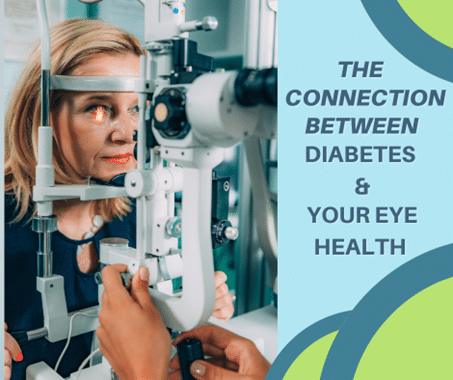Home » Blog » The Connection Between Diabetes & Your Eye Health
The Connection Between Diabetes & Your Eye Health
Posted by: South Georgia / North Florida Eye Partners in Blog

Did you know that there are 37.3 million Americans, according to the Centers for Disease Control (CDC), diagnosed with diabetes, and about 1 in 5 people with diabetes don’t know they have it? Being diagnosed with diabetes could have a connection to your eye health. If the blood sugar is high and uncontrolled, this threat could result in the diagnosis of diabetic retinopathy. Over time, having too much sugar in the blood can damage the retina. The retina is part of the eye that detects light and sends signals to your brain through a nerve in the back of the eye. We want to empower those with information diagnosed with diabetes or forward this newsletter to friends or loved ones who have been diagnosed with diabetes.
What Are The Symptoms of Diabetic Retinopathy?
Did you know that you can have diabetic retinopathy and not know it? This is because there are often no symptoms in its early stages. As diabetic retinopathy gets worse, you will notice symptoms such as:
- seeing an increasing number of floaters
- blurry vision
- a vision that sometimes changes from blurry to clear
- seeing dark or blank areas in your field of vision
- poor night vision
- noticing colors appear faded or washed out
- losing vision
Diabetic retinopathy symptoms usually affect both eyes.
What Are The Risk Factors
Risk factors relating to diabetic retinopathy are identical to factors that aggravate diabetes, which include:
- Obesity: Excess fat within the blood and body tissue makes it harder for insulin to regulate blood sugar levels effectively.
- Inactivity: Inactivity results in slow body metabolism, subsequently favoring high blood sugar levels
- Family History: Genetic factors affecting the pancreas cause inadequate production of insulin resulting in abnormally high blood sugar levels
- Age: The pancreas’ ability to produce adequate insulin decreases as a person gets older
- High Blood Pressure: The super-thin blood vessels within the retina rapture easily as a result of the abnormally high blood pressure
What Are The Two Main Stages of Diabetic Eye Disease?
NPDR (Non-Proliferative Diabetic Retinopathy)
NPDR is the early stage of diabetic eye disease. Patients who have had diabetes for five years stand a 25% chance of developing non-proliferative diabetic retinopathy (NPDR).
With NPDR, tiny blood vessels leak, making the retina swell. When the macula swells, it is called macular edema. NPDR is the most common reason why people with diabetes lose their vision.
PDR (Proliferative Diabetic Retinopathy)
PDR is a more advanced stage of the diabetic eye disease. At this stage, the retina starts growing new blood vessels. PDR is also called neovascularization. These fragile new vessels bleed into the vitreous. You may also see a few dark floaters if they only bleed slightly.
These new blood vessels can form scar tissue. Scar tissue can cause problems with the macula or lead to a detached retina.
PDR is very serious and can steal both your central and peripheral (side) vision.
Can Diabetic Retinopathy Go Away?
Your treatment is based on what your eye doctor sees in your eyes. The following treatment options may include:
- Medication
Medicine could help reduce swelling and slow vision loss and perhaps improve vision. Your eye doctor will recommend how many injections are needed over time.
- Medical Control
Controlling your blood pressure and blood sugar can stop vision loss. Carefully follow the diet recommended by your primary care doctor or nutritionist. Always remember to take the medicine that your doctor prescribed. Maintaining healthy numbers with your blood sugar and blood pressure can keep your eye’s blood vessels healthy.
Check out this video to learn more about diabetic retinopathy.
If you are part of the 1 in 10 who have diabetes, you can effectively delay the onset by making healthy lifestyle choices. However, it is prudent to have a yearly eye exam to allow your eye doctor to determine diabetic retinopathy onset when you have diabetes.
Your healthy eyes are our HIGHEST priority, and we are honored to be your partner in eye health!

References: American Academy of Ophthalmology, American Optometric Association, National Eye Institute, and Centers of Disease Control (CDC). This blog provides information and discussion about eye health and related subjects. The content provided in this blog and any linked materials are not intended and should not be considered medical advice. If the reader or any other person has a medical concern, they should consult with an appropriately licensed physician.
